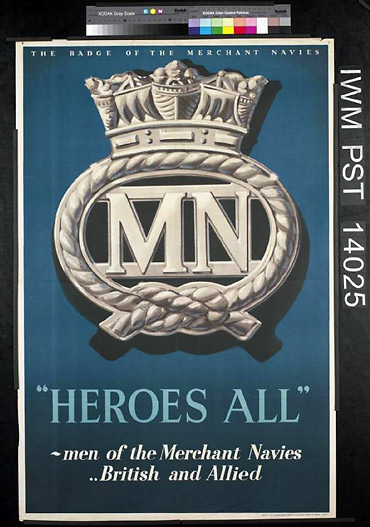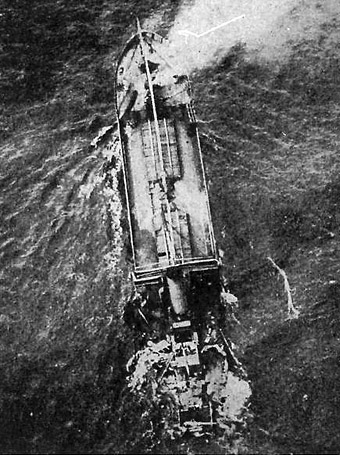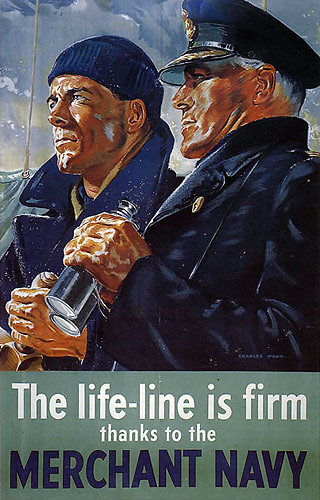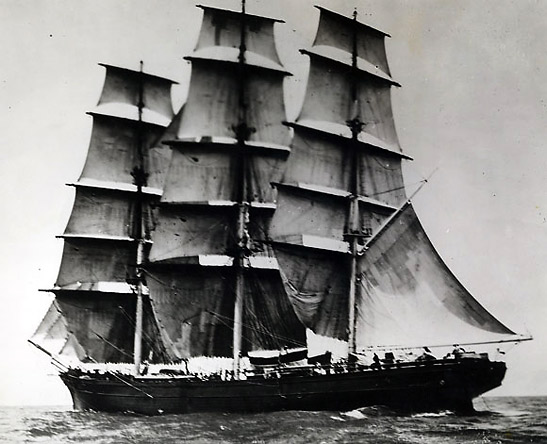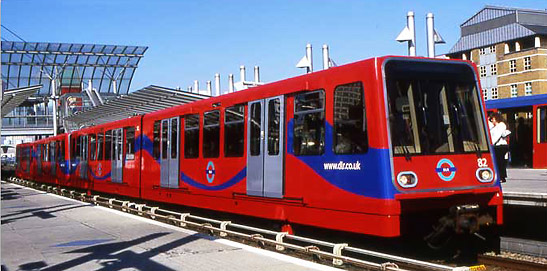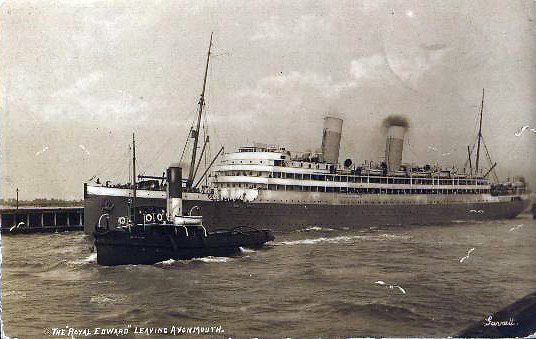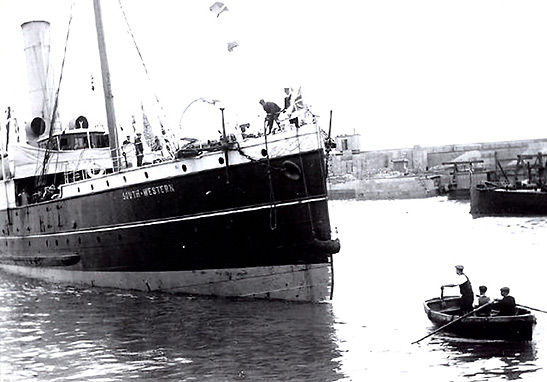 The American Merchant
Marine & The British Merchant Navy:
Every now and again – when I see all this – it reminds me of my days growing up in London in the 1940s and, on a fairly regular basis, seeing newspaper stories and newsreels about the British Merchant Navy as it’s called. These stories always highlighted the tremendous losses suffered not only by Great Britain, but also of their US counterparts and their Battles during the war of the Atlantic convoys – and the huge number of sinking’s of British and American ships caused by the underwater menace of Hitler’s U-boats. It’s strange what one remembers of one’s youth, because when I recall those long ago days now, the other fact that always jumps out is a vivid memory of how every day the British media was full of patriotic stories about how the British population felt about all this, and their attitude of “we’ll never surrender. We’ll tough it out.” A feeling that was echoed – very dramatically -- in the voices of the announcers on both the BBC and in newsreels shown in all the cinemas, as one could sense (even though I did not realize it at the time) that unmistakable British stiff upper lip approach of “How dare Hitler do this!” and “Doesn’t he realize he’ll never win!”
Looking back now I can see how full of bravado this all was, even though most people knew an invasion was a real possibility, and it could come at any moment. That was the infamous “Operation Sealion” of the Hitler regime’s plans for the invasion and conquest of England – but it never came to pass because Hitler’s Luftwaffe was unable to defeat the RAF – one of his primary conditions for the invasion. The outlook of the British people was one where the actual facts – the devastation caused by the incessant daily bombings, plus the overwhelming might of the Luftwaffe when compared to the skimpy resources of the RAF -- was always overlooked. It was best expressed in a very British way by a Cockney from London’s East End saying in a normal voice, yet still heard above all the fury of the battle, “’ow about cuppa tea mate?” Another specific fact from that time that also jumps out, is what the Brits call (and still do) “The Red Duster.” The official name is the Red Ensign, and it’s a banner all in red, with the top left hand corner featuring a small British flag. Its history goes back to the early 17th Century, when it was flown by the English Royal Navy, but was later flown specifically by British Merchant Seamen – that became known as the Merchant Navy.
Even though I was only a small boy at the start of WW2, I remember a Merchant Navy poster that was so powerful in its visual image and dramatic words, I still recall it all these years later. The Red Duster filled most of the poster and in the background some freighters, and the headline – “Under the Red Duster they sustain our Island Fortress.” Maybe it was because the news media wanted to “show the flag” while at the same time publicizing the Merchant Navy’s heroic actions, each photo frequently showed the Red Duster as it fluttered from the stern of a British cargo ship or oil tanker. I loved it then, and I still love it today when I see it on some British ship. Like so much of the “events” that concern the UK, the history of the MN goes back a long way. Starting in the 17th century the British merchant fleet began to grow bigger and bigger, until it became the world's foremost merchant fleet – its growth helped by the expansion of the British Empire, and the need for trade with British possessions around the world. This was particularly true as regards India and the Far East, and the hugely profitable business connected with sugar, spices, and that oh so British drink called tea.
As a travel journalist for much of my life, I was on my 4th travel media press trip to London, and part of the trip included a visit to Greenwich (pronounced by the Brits as Gren-ich, and not GREENWHICH) where you’ll find the classic, and beautiful Cutty Sark sailing ship. This gorgeous vessel was built in 1869, and was one of the fastest of her day – a fact that meant she played a vital role in the trade between Great Britain and India because of that speed. A tourist attraction in her own right, she’s been on public display at Greenwich since the early 1950s. Sadly, in May of 2007 she was badly damaged by fire, but was restored to her original glory and luster, and re-opened in April of this year. I recall going aboard her with my family in the mid 1980s, and was transfixed by all the artworks and tapestries inside her hull, each related to her history, when she sailed the seas between the UK and India – and beyond. If you love ships, I urge you make time to see her when you go to London.
Here’s another nifty idea for that trip. You can get to Greenwich by the unique driverless Docklands Light Railway, DLR. Since I last took this train, they have expanded their overall network, so that it now covers a wide area of London, and riding aboard it will, for sure, be one of your most intriguing trips in and around that historic city. For another offbeat experience in that part of London, when you take the DLR to Greenwich, get off at ISLAND GARDENS, because when you exit the station you’ll see the entrance to the tunnel that makes it possible to walk under the River Thames --- on your way to see the Cutty Sark. Because it’s such an unusual, offbeat tourist attraction in its own right, some facts that you’ll find interesting. It was begun in June 199 and opened in August 1902. It was originally built to serve residents from south London to go to (now get THIS very British name!) the “Isle of Dogs" for work. When l last checked, I learned it's used by about one and a half million people a year. Be prepared for a real walk, as it’s one thousand, two hundred and seventeen feet in length, and is 50 feet deep. Due to MY curiosity on such things, I asked a tourist official in London “about how many tiles are there in the tunnel’s new refurbishment?" I was told 200,000 glazed white tiles. Because the “thrill of TV” was still on the horizon in the 1940s, audiences flocked to the cinema to see the newsreels that covered the major stories of the day. I can still hear the announcer’s dramatic voice as he described the ongoing U-boat menace in the Atlantic. These black and white films also publicized the crews, and their battles with the U-boats and, now and again, footage showing anti aircraft fire from the convoy’s escorts that greeted any of the long range Luftwaffe bombers called the Condor -- when they were sent to “check out” the convoys – and pass that information to U-boat headquarters in France. As I sat glued to my seat watching all this unfold on the huge cinema screen before me, I found it hard (even as a child) to understand how anyone would volunteer for service in the Merchant Navy. The UK suffered 11.7 million tons of shipping lost to the dreaded U-boats, and over 30,000 British merchant seamen lost their lives as they fought to keep this vital “passage” between Great Britain and America open. Their cargoes covered the gamut of foods, fuel and other items needed to sustain the hard pressed citizens of the UK. America was the savior of England. The other factor that’s always intrigued me as I became an adult, is the number of famous Brits who were, at one time or another, part of the British Merchant Navy. World famous author Joseph Conrad joined in 1874, but left (thank goodness for literature!) in 1886 to write his superb novels. Ken Russell, an innovative British film director was a merchant seamen, as was Alun Owen who wrote the screenplay for the Beatles hit movie A Hard Days Night – then there’s Kevin McClory, an Irishman who spent 14 days in a lifeboat after his ship was torpedoed, who later went on to write the James Bond movie Never Say Die.
The ranks of those who served in the British Merchant Navy and the American Merchant Marine, are passing away by the day – and soon all will be gone. We owe all of them a huge debt of gratitude for their service to their country; to their courage; and for what they did to help defeat the enemy on the high seas of the world back in those dark days of WW2. God Bless all of you. Related Articles: |
